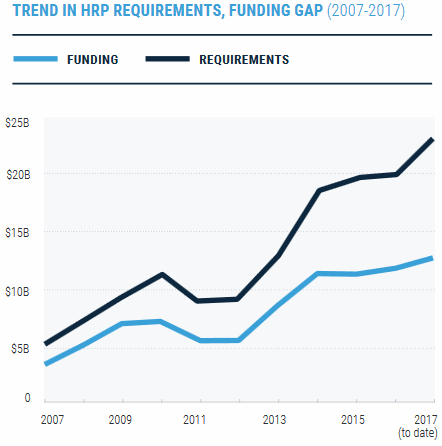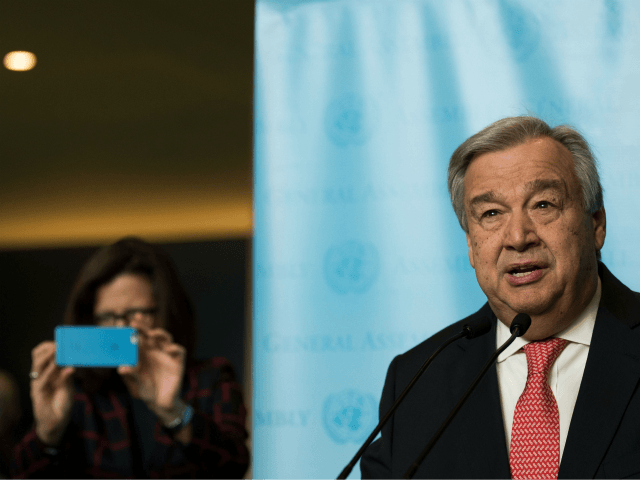This morning’s key headlines from GenerationalDynamics.com
- UN asks for 2018 increase in humanitarian aid despite compassion fatigue
- Humanitarian crises continue to grow year after year
UN asks for 2018 increase in humanitarian aid despite compassion fatigue

Funding gap for humanitarian aid for each year 2007-2017, showing gap between needed funds and received funds. HRP = Humanitarian Response Plans.
The United Nations is asking the world community for an increase in donations for humanitarian aid, requesting $22.5 billion for 2018, above the $22 billion originally requested for 2017. More than $10 billion is needed to address the humanitarian crises in Syria and Yemen alone.
According to the “Global Humanitarian Overview 2018” report published on Friday:
Many humanitarian crises have become so protracted that they seem permanent. Nineteen of the 21 humanitarian response plans presented in this overview are for humanitarian crises that have been running for five years or more. Three have had humanitarian plans and appeals each year for at least 18 years (Democratic Republic of the Congo, Sudan and Somalia).
The steep rise in funding requirements over the years is mainly driven by a set of large-scale protracted crises with humanitarian funding requirements over a billion dollars per year (primarily the Syria crisis, Yemen and South Sudan).
Food insecurity is also often a consequence of protracted conflict. In late 2017, the Famine Early Warning Systems Network (FEWSNet) highlighted 12 countries in which at least a half-million people will need emergency food assistance (Yemen, Ethiopia, South Sudan, Afghanistan, Nigeria, Somalia, Sudan, DR Congo, Uganda, Kenya, Central African Republic and Niger). Of these, five are rated in the ‘emergency’ phase of food insecurity, one step short of the worst phase of ‘famine’. Four (Yemen, South Sudan, Somalia and Nigeria) are still at risk of famine conditions.
In the request for 2017 (the current year), the $22 billion was requested to help 92.8 million people in need. Over the course of the year 2017, additional crises increased the need for $24 billion, to help 105.1 million people.
However, there is little chance and the UN will get the funding that it is requesting. The number of humanitarian crises around the world has been increasing sharply. This requires a lot more humanitarian aid, but it also creates a lot more “compassion fatigue” among potential donors, who (correctly) see the demands for humanitarian aid increasing constantly, but then draw the conclusion that they are no longer willing to respond with money.
The graph above shows the funding requested (black line) and funding received (blue line). As the graph shows, the amount of funding requested has been increasing much faster than the amount of funding received.
So in 2017, $22 billion was initially requested, rising to $24 billion during the year, but the actual funding received was just $12.6 billion, or just 52 percent of the amount needed, according to the UN. Relief Web and Global Humanitarian Overview 2018 (PDF)
Humanitarian crises continue to grow year after year
As you can see from the above graph, the amount of funding requested went up during the financial crisis until 2010, then fell and leveled off, and then began to surge in 2012. This was the time following the “Arab Spring,” when the Mideast and other places in the world began to seriously destabilize. In the Mideast, the war in Libya began, and the genocide in Syria by the Bashar al-Assad also began. More crises began in the years that followed. In Central Asia, the Burma genocide and ethnic cleansing of the Rohingya Muslims began. In North America, the Haiti earthquake was an enormous disaster. In Africa, wars in South Sudan, Mali, and Central African Republic started, followed by the war in Yemen.
On top of that, there were continuing humanitarian crises in some countries. In three countries, they had lasted for at least 18 years: Democratic Republic of the Congo, Sudan, and Somalia.
I remember reading an article in 2004 claiming that the number of wars in the world was at the lowest in history. That was the end of the generational Unraveling era, a time during the 1990s when the world was run by the Silent generation of people who had grown up in the 1930s. They had lived through World War II, and had learned the dangers of extreme nationalism, xenophobia, large refugee flows, and unmet humanitarian crises. Since the world leaders were well aware of these dangers, they made sure that they would not spiral out of control.
Since 2003-4, most of the world has been in a generational Crisis era, with the survivors of WW II disappearing. And now, about 14 years into a Crisis era, we see all the things that led to WW II occurring again, leading up to a new world war. The things that the World War II survivors devoted their lives to keep from happening again are now happening again and spiraling out of control.
In yesterday’s World View article on the rise of slavery and slave auctions in Libya, I described how huge migration flows in Africa, the Mideast, Central Asia, and even in Beijing China are destabilizing major regions of the world, depleting resources and triggering xenophobia and violence. At the same time, “compassion fatigue” means that less aid is available for desperate people.
All of these factors – slave auctions, growing refugee flows, growing humanitarian crises – are factors that have occurred in the 1930s and prior to other major wars in history, and they are only going to continue growing, and lead to a new world war.
In 2018, expect more countries to become unstable, more refugee flows, more slave auctions, and more humanitarian crises, and expect more intolerance and political bickering by politicians overwhelmed by the crises and looking for easy solutions that do not exist. From the point of view of Generational Dynamics, that’s what always happens in a generational Crisis era. AFP and Al Jazeera and Reuters
Related Articles
- European-African summit calls for end to slavery auctions in Libya (01-Dec-2017)
- The Gathering Storm: The accelerating surge in refugees, slaves and terrorists (20-Jun-2015)
- Afghan and Eritrean migrants clash at site of ‘Jungle’ in Calais France (24-Aug-2017)
- Xenophobic violence against migrants returns to South Africa (27-Feb-2017)
- Russian and Syrian war crimes are ‘weaponizing’ the refugee crisis for Europe (02-Mar-2016)
- Thousands of Bangladeshi and Burma Rohingya migrants stranded at sea in southeast Asia (16-May-2015)
KEYS: Generational Dynamics, United Nations, Global Humanitarian Overview, Syria, Yemen, Sudan, Libya, Burma, Myanmar, Democratic Republic of the Congo, Sudan, Somalia
Permanent web link to this article
Receive daily World View columns by e-mail

COMMENTS
Please let us know if you're having issues with commenting.